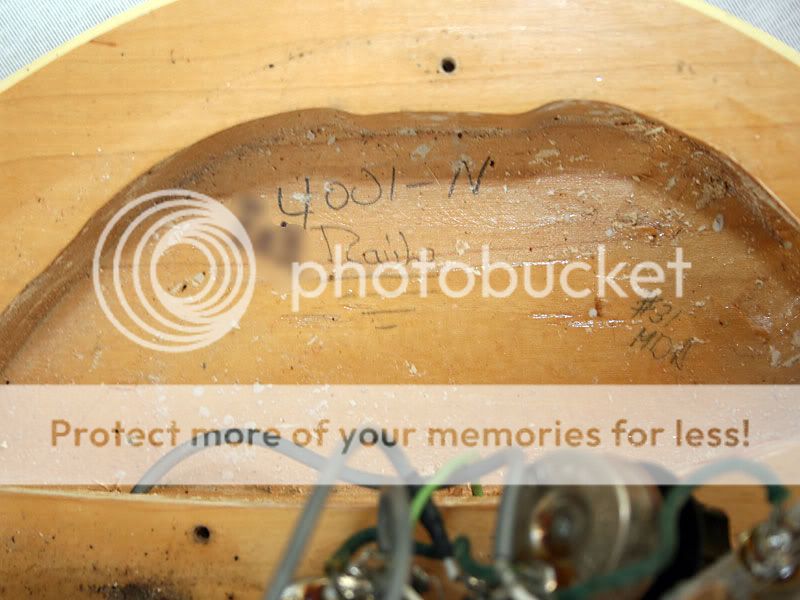I apologize for the unintended break. Life intruded.
John, I think I will fix the lift -- in for a penny, etc. Thanks for doing the legwork for me!
Let's strip this baby down. First thing off is the strap:

I'd venture to say that the strap hasn't been off in 30 years. My locking "system" is a conical washer at each bolt. It means that you can't take the strap off easily, but at least it never failed. The reason for my paranoia -- which I'd forgotten about -- will be revealed shortly.
Next off were the strings, which haven't been changed in at least ten years:

And that's when I remembered why I'd gone to an extreme with my straplocks: an enthusiastic Townshend leap had freed the bass from the strap and sent it headstock-down to the ground, with the D key taking the brunt of the impact. The cover popped off and the key bent. I "repaired" it with epoxy and a week's worth of clamping which, believe me, made rehearsals awkward and tiring, since the only pressure I could come up with was an iron c-clamp that weighed about two pounds (hey, I was young and stupid). You can see the jaw marks from where I clenched the key itself in a vise to straighten it. The thing is, since the key fell apart when I removed the string, 1) the epoxy gave up the ghost some time ago; and 2) string tension alone must have been holding it together. Odd.

Somewhere around here I've seen tips on making a proper repair of this type. One more thing for the list.
I stripped off the hardware about two weeks ago, so I don't remember what possessed me to flip the bass over, but I did. I also don't know why it didn't occur to me that the bridge would fall out, but it did.

At that point, it occurred to me that maybe not everyone has seen a 4001 bridge out in the wild, so I caught a couple of pics. Rear view, with adjustment screws totally exposed:

What it looks like inside, simple and clever:

Oh wait. Now I remember why I flipped it over -- to remove the rest of the keywinds. Four little screws hold them on.

That's not errant epoxy in the cavity of the broken key, it's grease. (Am I the only one who finds the look of the unstrung, de-keyed flanges slightly comical? Maybe it's just the angle, but Cookie Monster popped into my head.) Here's a question for the group: how do I get those flanges out? It's not apparent how they're being held in, and I expected them just to slide out. I can't think of a way to remove them that I'm not certain won't damage the finish. Tips?
On to the tailpiece. It's held by five screws of two different types; the pair to the rear create the fulcrum across which tail lift develops.

It seemed prudent to free the mute pad first (I'm sure it's noted elsewhere, but it's worth pointing out that the mute bolts are the same as the ones for the strap). A little mindless screwing (pardon the expression), during which I pondered the next, more complicated, steps, and the tail was free:

The springs provide tension for the mute pad.
Up to this point, things have been straightforward: oh look, this screw holds that on; tab A comes out through slot B. But when you get to the pickguard and all it encloses, things get more complicated. Easy enough to get started, though. Setscrews secure the tone and volume knobs, and a threaded ring retains the switch:

Thin nuts and washers (similar, but not identical, to those on 1/4" phone jacks) hold the pots to the pickguard. The little screws come from the guard itself:

Here's where it got tricky. Maybe there's a very thin-walled socket that can glom onto those jack nuts, but I don't have one, and in any case, the ex got the tool kit in the settlement. I thought maybe if I released the plate, I could get behind it and twist (gently!) the jacks themselves, but they're packed in
tight. Then I remembered a tool kit I
do have: my culinary batterie (one of several things I do to make a living is teach cooking classes). Depending on context, these are hemostats, a roach clip or tweezers for removing pinbones from fish. And now they have another skill for their resumé -- tight-clearance pliers.

Getting those off let me uncover the electronics.

Here's a close-up for pot heads:

For some reason, I didn't record removal of the bridge pup (the toaster is still attached to the pickguard), but all that's required is unscrewing the four screws at the top and bottom of the surround (not the large ones flanking the pickup). With all the cavities depopulated, you can see some historical inscriptions. Tailpiece:

I can make out the names Maria and Ortiz, but they don't appear to be in the same handwriting.
Neck -- proof that I've been here before: that blurred writing upper right is my social security number. Good thing the bass never got stolen, because I'd completely forgotten that I'd done this. Still, it demonstrates that I wasn't
consistently young and stupid.

Bridge pickup. Its destiny is cast in . . . red china marker.

Unless, of course, that doesn't mean "natural" but Nathaniel.
Electronics cavity.

Another SS number, as well as model designation ("N" for natural?), and another name: Raul. Anyone know what "#31 MDN" might mean?
Comments, tips and tricks are welcome -- as are requests for anything I haven't photographed or explained, or not photographed or explained clearly enough. I'm off to learn how to solder before the next step!


















